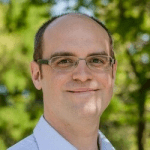What Does the Future of Computing Look Like? Zapata Computing May Have an Answer in “Big Compute”

Like many world-leading quantum computing companies, Zapata Computing has thought a lot about how quantum computing will coexist with classical computing. Jay Liu, Vice President of Product, and his team are preparing for the era that they call “Big Compute”—an era where quantum and classical technology will work together in a hybrid system.
Defining Big Compute
As Liu explained, Big Compute is the natural progression from two previous eras of computing technology development. First, there was Big Data. Developments including the cloud and the “internet of things” enabled organizations and companies to analyze, store, and share massive volumes of data. The accessibility of this data set the stage for the next phase of evolution: the evolution of algorithms to process this data.
Liu refers to this as the era of “Big Models.” Here, Liu sees algorithms — specifically machine learning models — becoming more advanced and helping organizations gain more meaningful insights from their data, which they can then use to inform their business decisions, for example in the form of predictive or prescriptive analytics. This seems to also be the case for quantum algorithms, as many companies are working to develop quantum algorithms that can be used to optimize problem-solving and other processes.
But as these algorithms grow more powerful, they also demand more computing power. This calls for a third stage in the evolution: the evolution of hardware. This, Liu says, is the age of Big Compute. He believes it’s this third evolution where quantum computing will be the most impactful.
Unlike software and algorithms, Liu predicts that there will be a significant bottleneck in hardware development, as physical computing devices can only output so much power. Moore’s Law, which fueled advances in computing power over the last few decades, is finally hitting a wall as transistors reach the point where they physically can’t get any smaller. “Computing power is slowly becoming stuck,” Liu said. “And quantum computing is the key to making it unstuck.” To overcome the bottleneck in computing power, Liu and the team at Zapata Computing envision a computing system combining classical computing devices, like GPUs, CPUs, and emerging quantum computing devices.
To connect these many different devices, a layer of orchestration will be required, where software can define and delegate tasks to the specific computing devices best suited for executing them, whether they be classical or quantum. The combination of classical and quantum computing devices makes for a powerful system that could boost computing power in novel ways. “Quantum algorithms or quantum devices cannot solve big problems alone,” Liu stated. “These problems need a system of hybrid devices, and an intelligent software layer to orchestrate the flow of data and the execution of algorithms across different hardware backends.”
To accelerate the age of Big Compute, Liu and the Zapata Computing team are developing their hybrid quantum software platform Orquestra, which will interface between the multiple different computing devices, both quantum and classical. This system would also be flexible enough to integrate with different types of quantum computers (photonic, superconducting, neutral atom, and more), in addition to future quantum devices. This would allow problem-solving workflows to be forward-compatible with future advances in hardware.
Liu sees the current quantum ecosystem as being somewhat fragmented between software and hardware development, and he hopes that Zapata Computing and the Big Compute framework can bridge that gap. “People need it now to experiment and try out,” Liu commented. As the fragmentation Liu sees will only lead to further divides and more extreme talent shortages, Liu believes that Orquestra can help solve these problems and, in turn, help evolve the quantum ecosystem into a closer-working community. Liu added, “We are building a connection tool, middleware not just between classical and quantum devices, but also between hybrid hardware and hybrid software.”
Kenna Hughes-Castleberry is a staff writer at Inside Quantum Technology and the Science Communicator at JILA (a partnership between the University of Colorado Boulder and NIST). Her writing beats include deep tech, the metaverse, and quantum technology.





















